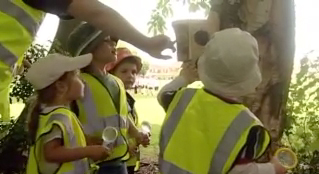1.1 Developing language skills
You are now going to switch your focus to toddlers and nursery-age children. We’d like you to look at how Claire, a nursery worker, made use of the natural environment around her setting to develop the language skills of some of the children in her care.
Activity 2
Part 1

Transcript
Nature trail
In the video above, Claire is taking four children to a ‘forest’ to explore the area and to observe insects and birds. As you watch, try to identify and record examples of how Claire talked to the children, using the five specific ways of positively communicating with children identified by Hart and Risley (1999, cited in Roberts, 2009) in their study.
Give an example against each of the five specific ways to show how Claire has used them to communicate with the children. Some examples have been given in Table 1 to get you started. You can either draw your own table or use the version we have provided in a Word document. You may need to watch the video several times to catch what is said.
When you have finished, compare your observations with ours. You may not notice much conversation as part of daily life in the clip. This is because it has been recorded to show a nursery worker carrying out a particular activity, rather than an everyday conversation between a parent or carer and a child, as in the Hart and Risley study.
| Specific way of talking to children | Our example | Your example |
|---|---|---|
| Talking as part of everyday life | Step over the stick if you want to go a bit closer. | |
| Being nice | Shall I lift you up to have a look so you can see it a bit better? [kindly tone] | |
| Giving information | I have got a bug on me now. I have got a little fly on me, look. | |
| Giving choices | Shall we put the log back down then? | |
| Listening and responding | The birds, yeah. [in response to child’s answer] |
Comment
When you have finished completing Table 1, compare your observations with ours. Which part of the table did you find most difficult to complete? Were there more examples of one way of talking?
Table 2 shows more instances of how Claire communicated using the five specific ways of talking to children. These are not the only possible answers. You have probably found other examples.
| Specific way of talking to children | Further examples |
|---|---|
| Talking as part of everyday life | Jack come over here a minute and look. |
| Being nice | Let’s put it down carefully then so we don’t hurt them. |
| Giving information | I’ve got a bug on me now. I’ve got a little fly on me, look. |
| Giving choices | There look, that’s a different one isn’t it? |
| Listening and responding | Is it my pet? |
Part 2
Now think about how you would structure a similar activity in your own setting. What vocabulary would you choose? It doesn’t have to be about birds and plants.
You might also find it useful to use the five points listed above to analyse a conversation with young children in your setting. Remember that these early communications are an important foundation in the development of literacy. They are helping to build up vocabulary as well as introducing young children to different patterns of speech and language.
1 Babies and the early years
